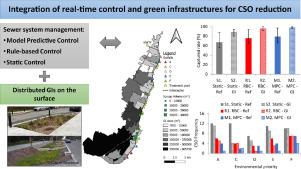Water Research ( IF 11.4 ) Pub Date : 2022-06-14 , DOI: 10.1016/j.watres.2022.118753 Marie-Ève Jean 1 , Camille Morin 1 , Sophie Duchesne 1 , Geneviève Pelletier 2 , Martin Pleau 3

|
The impact of integrating large-scale distribution of green infrastructures (GIs) with different real-time control strategies on combined sewer overflows (CSOs) is assessed for the southern area of the City of Montreal's combined sewer system (Canada). An iterative process involving a synthetic design rainfall event and model predictive control (MPC) of the sewer system is developed to distribute GIs according to cost-efficiency and spatial analysis criteria. The distributed GIs are alternatively integrated with static, rule-based control (RBC) and MPC, for which model simulations are performed for a two-month period. The performance of the three strategies is compared in terms of CSO volume and frequency reductions, fulfillment of the outfall environmental priorities and transfer of runoff capture to CSO volume reduction. A gradual increase in GI implementation levels and an alternative scenario of GIs distribution are also considered to assess the performance of the two real-time control (RTC) strategies. By comparing the scenarios where GIs are uniformly distributed with those where no GIs are implemented and omitting the most extreme rainfall event, average CSO volume reduction is about 65%, 82% and 92%, respectively, for static control, RBC and MPC. Moreover, the scenario integrating GIs with MPC is the only one permitting to avoid almost all CSO events and the fulfilment of the outfall environmental priorities. GIs efficiency performance (the transferability between global runoff capture and CSO volume reduction) is also the highest under MPC, even when considering varying GI implementation levels and spatial distribution schemes.
中文翻译:

使用绿色基础设施进行实时模型预测和基于规则的控制,以减少综合下水道溢流
评估了蒙特利尔市联合下水道系统(加拿大)南部地区将大规模分布的绿色基础设施 (GIs) 与不同的实时控制策略对联合下水道溢流 (CSOs) 的影响。开发了一个涉及综合设计降雨事件和下水道系统模型预测控制 (MPC) 的迭代过程,以根据成本效益和空间分析标准分配地理标志。分布式地理信息系统交替与静态、基于规则的控制 (RBC) 和 MPC 集成,模型模拟执行为期两个月。在 CSO 体积和频率减少、排放口环境优先事项的实现以及径流捕获转移到 CSO 体积减少方面比较了三种策略的性能。还考虑逐步提高地理标志实施水平和地理标志分布的替代方案,以评估两种实时控制 (RTC) 策略的性能。通过比较 GIs 均匀分布的情景与未实施 GIs 的情景并忽略最极端的降雨事件,静态控制、RBC 和 MPC 的平均 CSO 体积减少分别约为 65%、82% 和 92%。此外,将 GIs 与 MPC 相结合的方案是唯一允许避免几乎所有 CSO 事件和实现排放口环境优先事项的方案。地理标志效率性能(全球径流捕获和 CSO 体积减少之间的可转移性)在 MPC 下也是最高的,即使考虑到不同的地理标志实施水平和空间分布方案也是如此。











































 京公网安备 11010802027423号
京公网安备 11010802027423号